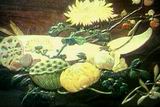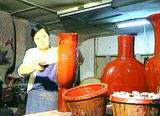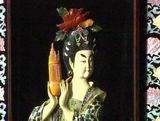 |
|
Yangzhou's Carved Lacquer Inlaid with Jade |
| CCTV.COM 2003-10-29 09:10:42 |
|
 Yangzhou has been an important lacquer ware center in China since ancient times. The history of lacquer work in China goes back to the Western Han Dynasty more than 2,000 years ago. Yangzhou lacquer work reached its pinnacle in the 18th century during the Qing Dynasty when its lacquer artists began to use jade and other precious stones in the adornment of carved lacquer. Yangzhou has been an important lacquer ware center in China since ancient times. The history of lacquer work in China goes back to the Western Han Dynasty more than 2,000 years ago. Yangzhou lacquer work reached its pinnacle in the 18th century during the Qing Dynasty when its lacquer artists began to use jade and other precious stones in the adornment of carved lacquer.
“Carved lacquer inlaid with jade appeared during the Ming Dynasty (l368-l644). In fact, the technique of jade inlay on lacquer ware originated in the Han period. But the technique was not perfected and fully utilized until the Ming period,” said Zhang Changming, specialist in arts and crafts from Jiangsu Province.
Yangzhou craftsmen inherited the technique of tihong (carved red lacquer) developed during the Tang Dynasty, which existed from 618 to 907. The basis of carved lacquer is usually wood. Lacquer is applied to the wooden surface in as many as 200-300 thin layers until the lacquer is built up to a considerable thickness. When the lacquer is cold and hard, carving is done as required by the design. The carving is delicate and precise and often achieve a three-dimensional effect.
 Zhou Zhu, a lacquer artist from Yangzhou, who lived during the Ming period, developed the method of ornamenting lacquer ware with gold, silver, and various precious stones. To remember him, people call this type of lacquer ware Zhou ware. Zhou Zhu, a lacquer artist from Yangzhou, who lived during the Ming period, developed the method of ornamenting lacquer ware with gold, silver, and various precious stones. To remember him, people call this type of lacquer ware Zhou ware.
After years of practice, the Qing Dynasty lacquer artist Lu Yingzhi successfully applied the inlay technique to the manufacture of carved lacquer ware. Noted for its superb workmanship and esthetic value, Yangzhou's carved lacquer inlaid with jade and other precious materials was highly admired by the Imperial family and was listed among goods selected as tribute for the court.
“Diaoqi is the Chinese for carved red lacquer. The wood or metal basis of such objects is coated some 100 times with vermilion paint. Then it is carved and inlaid with patterns made of various precious stones,” said Zhao Zhishuo, curator, Museum of Arts and Crafts of China.
 These two sets of carved lacquer hanging scrolls from Yangzhou were once displayed in the Great Hall of the People in Beijing. One set is entitled Ode to Peace and the other Magpies and Plum Tree. Each set is l3.5 meters high and two meters wide. They are exquisitely carved and feature doves – symbols of peace, magpies – harbingers of spring, and plum and peony flowers carved out jade of different colors as well as agate and coral. These two sets of carved lacquer hanging scrolls from Yangzhou were once displayed in the Great Hall of the People in Beijing. One set is entitled Ode to Peace and the other Magpies and Plum Tree. Each set is l3.5 meters high and two meters wide. They are exquisitely carved and feature doves – symbols of peace, magpies – harbingers of spring, and plum and peony flowers carved out jade of different colors as well as agate and coral.
Yangzhou-carved lacquer articles inlaid with precious stones are noted for their natural color and beautiful designs. Graceful and infused with rich Chinese national color, they are much sought after by art lovers.
|
|
Editor: Han Ling CCTV.com
|
|
|
|
|
|
 |









